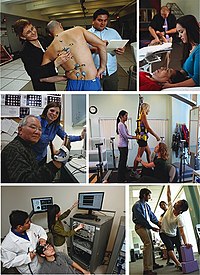
High‐frequency motor rehabilitation in amyotrophic lateral sclerosis: a randomized clinical trial
Sign Up to like & getrecommendations! Published in 2019 at "Annals of Clinical and Translational Neurology"
DOI: 10.1002/acn3.765
Abstract: Exercise may be physically and psychologically important for people with ALS, especially in the earlier stages of the disease, and, as a consequence, current ALS clinical management includes individualized rehabilitation as part of multidisciplinary care… read more here.
Keywords: motor rehabilitation; high frequency; rehabilitation amyotrophic; frequency ... See more keywords

Gamification and neurological motor rehabilitation in children and adolescents: A systematic review.
Sign Up to like & getrecommendations! Published in 2021 at "Neurologia"
DOI: 10.1016/j.nrl.2021.02.011
Abstract: INTRODUCTION Gamification consists of the use of games in non-playful contexts. It is widely employed in the motor rehabilitation of neurological diseases, but mainly in adult patients. The objective of this review was to describe… read more here.
Keywords: motor rehabilitation; rehabilitation children; review; children adolescents ... See more keywords

Motivation in pediatric motor rehabilitation: A systematic search of the literature using the self-determination theory as a conceptual framework
Sign Up to like & getrecommendations! Published in 2018 at "Developmental Neurorehabilitation"
DOI: 10.1080/17518423.2017.1295286
Abstract: ABSTRACT Objective: Motivation is suggested as an important factor in pediatric motor rehabilitation. Therefore, we reviewed the existing evidence of (motivational) motor rehabilitation paradigms, and how motivation influences rehabilitation outcome using self-determination theory as conceptual… read more here.
Keywords: motor rehabilitation; framework; pediatric motor; rehabilitation ... See more keywords

Spinal stimulation for motor rehabilitation immediately modulates nociceptive transmission
Sign Up to like & getrecommendations! Published in 2022 at "Journal of Neural Engineering"
DOI: 10.1088/1741-2552/ac9a00
Abstract: Objective. Spinal cord injury (SCI) often results in debilitating movement impairments and neuropathic pain. Electrical stimulation of spinal neurons holds considerable promise both for enhancing neural transmission in weakened motor pathways and for reducing neural… read more here.
Keywords: spinal stimulation; nociceptive transmission; transmission; motor ... See more keywords

Tactile Sensation Improves Following Motor Rehabilitation for Chronic Stroke: The VIGoROUS Randomized Controlled Trial
Sign Up to like & getrecommendations! Published in 2022 at "Neurorehabilitation and Neural Repair"
DOI: 10.1177/15459683221107893
Abstract: Background. Up to 85% of people with chronic stroke experience somatosensory impairment, which contributes to poor sensorimotor control and non-use of the affected limb. Neurophysiological mechanisms suggest motor rehabilitation may improve tactile sense post-stroke, however,… read more here.
Keywords: sensation; tactile sensation; rehabilitation; chronic stroke ... See more keywords

Motor Activated Auricular Vagus Nerve Stimulation as a Potential Neuromodulation Approach for Post-Stroke Motor Rehabilitation: A Pilot Study.
Sign Up to like & getrecommendations! Published in 2023 at "Neurorehabilitation and neural repair"
DOI: 10.1177/15459683231173357
Abstract: BACKGROUND Implanted vagus nerve stimulation (VNS), when synchronized with post-stroke motor rehabilitation improves conventional motor rehabilitation training. A non-invasive VNS method known as transcutaneous auricular vagus nerves stimulation (taVNS) has emerged, which may mimic the… read more here.
Keywords: vagus nerve; nerve stimulation; motor; stimulation ... See more keywords

Kinect and wearable inertial sensors for motor rehabilitation programs at home: state of the art and an experimental comparison
Sign Up to like & getrecommendations! Published in 2020 at "BioMedical Engineering OnLine"
DOI: 10.1186/s12938-020-00762-7
Abstract: Background Emerging sensing and communication technologies are contributing to the development of many motor rehabilitation programs outside the standard healthcare facilities. Nowadays, motor rehabilitation exercises can be easily performed and monitored even at home by… read more here.
Keywords: motor rehabilitation; home; motion; rehabilitation programs ... See more keywords

The Use and Outcomes of Motor Rehabilitation Services Among People With Cerebral Palsy Change Across the Lifespan
Sign Up to like & getrecommendations! Published in 2022 at "Frontiers in Neurology"
DOI: 10.3389/fneur.2021.771348
Abstract: Background and Aims The provision of coordinated and multidisciplinary rehabilitation programs that adapt to the individual with cerebral palsy (CP) evolving rehabilitation needs throughout the different phases of life is highly challenging for healthcare systems.… read more here.
Keywords: outcomes motor; rehabilitation; use outcomes; cerebral palsy ... See more keywords

Cortico-muscular coupling to control a hybrid brain-computer interface for upper limb motor rehabilitation: A pseudo-online study on stroke patients
Sign Up to like & getrecommendations! Published in 2022 at "Frontiers in Human Neuroscience"
DOI: 10.3389/fnhum.2022.1016862
Abstract: Brain-Computer Interface (BCI) systems for motor rehabilitation after stroke have proven their efficacy to enhance upper limb motor recovery by reinforcing motor related brain activity. Hybrid BCIs (h-BCIs) exploit both central and peripheral activation and… read more here.
Keywords: movement; brain; motor; upper limb ... See more keywords

Evaluation Results of an Ontology-based Design Model of Virtual Environments for Upper Limb Motor Rehabilitation of Stroke Patients.
Sign Up to like & getrecommendations! Published in 2017 at "Methods of information in medicine"
DOI: 10.3414/me16-02-0017
Abstract: OBJECTIVES 1) To enhance the content of an ontology for designing virtual environments (VEs) for upper limb motor rehabilitation of stroke patients according to the suggestions and comments of rehabilitation specialists and software developers, 2)… read more here.
Keywords: motor rehabilitation; ontology; rehabilitation; upper limb ... See more keywords